The visual computing group studies problems at the intersection of computer graphics and computer vision, focusing on the analysis and synthesis of geometric data sets. Key research topics include correspondence problems, symmetry detection, composite data models such as discovery of building blocks and inverse procedural modeling, and direct techniques for generative and discriminative modeling of data. Further, the group has expertise in processing and visualization of large geometric data sets.
OVERVIEW
Shape Understanding: Our research focus is on data driven and structure aware methods in computer graphics. In particular, we are interested in analysis and synthesis of geometric data using statistical tools from computer vision. Informally spoken, we would like to devise techniques that are to some extend able to “understand” geometric data sets.
Other modalities: We are also interested in other types of spatial data, such as 2D images, 3D volume data, and higher dimensional (abstract) data spaces.
Interdisciplinary applications: The computer science department at University of Mainz has a strong focus on interdisciplinary applications, in particular in natural science and other empirical disciplines. We are interested in applying our data analysis and modeling techniques in a broader interdisciplinary context. At this point, this is subject to ongoing work
Below, we discuss the key results obtained so far.
CURRENT RESEARCH TOPICS
Deep Generative Models
 Recently, deep (convolutional) neural networks have demonstrated very strong results in both discriminative (for example, image recognition) and generative (image synthesis) tasks. We have tried combining traditional Markovian compositional models (see inverse procedural modeling section below) with deep representations, which yields encouraging results (non-photo-realistic style transfer, photo-realistic image synthesis).
Recently, deep (convolutional) neural networks have demonstrated very strong results in both discriminative (for example, image recognition) and generative (image synthesis) tasks. We have tried combining traditional Markovian compositional models (see inverse procedural modeling section below) with deep representations, which yields encouraging results (non-photo-realistic style transfer, photo-realistic image synthesis).
Key Publications
- Chuan Li, Michael Wand: Precomputed Real-Time Texture Synthesis with Markovian Generative Adversarial Networks. In: IEEE European Conference on Computer Vision (ECCV), 2016 (to appear).
paper preprint (arXiv.org) code (github) - Chuan Li, Michael Wand: Combining Markov Random Fields and Convolutional Neural Networks for Image Synthesis. In: IEEE Conference on Computer Vision and Pattern Recognition (CVPR), 2016.
paper preprint (arXiv.org) code (github)
Inverse Procedural Modeling
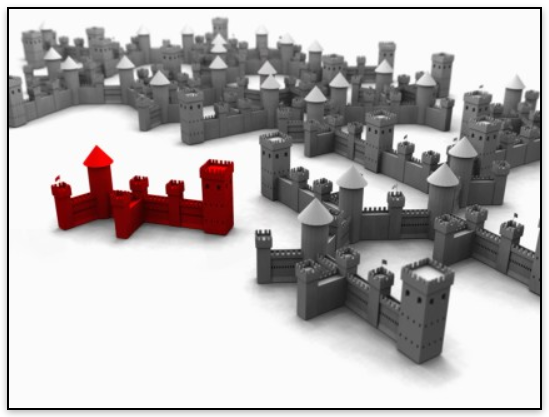
Inverse procedural modeling refers to the process of estimating rules how to build a shape from one or more example shapes. We are looking at fully automatic techniques that can derive shape grammars from example shapes. We use partial symmetries of an object to find a grammar that describes a family of shapes that are similar to the exemplar in a formal sense.
Key Publications
- M. Bokeloh, M. Wand, H.-P. Seidel: A Connection between Partial Symmetry and Inverse Procedural Modeling. In: ACM Transactions on Graphics (Siggraph 2010).
paper (high-res, 24MB), paper (low-res, 1.8MB), video (Youtube) - M. Bokeloh, M. Wand, V. Koltun, H.-P. Seidel: "Pattern-Aware Deformation Using Sliding Dockers", In: ACM Transactions on Graphics (Proc. Siggraph Asia), 2011.
paper (preprint, PDF, 22MB), video (mp4, 72MB) - M. Bokeloh, M.Wand, H.-P. Seidel, V. Koltun: An Algebraic Model for Parameterized Shape Editing. In: Proc. SIGGRAPH 2012.
paper (preprint, PDF, 40MB)
Symmetry Detection
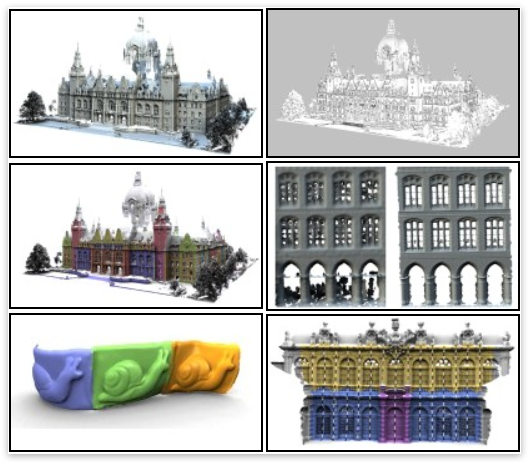
Given a 3D model, we would like to compose this model into elementary building blocks. Each building block consists of the same geometry up to a certain transformation (rigid motion, isometry, more general deformation) and possibly noise. We are looking at algorithms that can compute such decompositions fully automatically, without user supervision.
Key Publications
- M. Bokeloh, A. Berner, M.Wand, H.-P. Seidel, A. Schilling: Symmetry Detection Using Line Features. In: Computer Graphics Forum, Proc. Eurographics '09.
paper (10 MB), video: avi/xvid (40MB) quicktime (32MB). - Jens Kerber, Martin Bokeloh, Michael Wand, Hans-Peter Seidel: Scalable Symmetry Detection for Urban Scenes. In: Computer Graphics Forum, 2013.
technical report (13 MB), video (mp4, 76MB), full paper (publisher site). - J. Kalojanov, M. Bokeloh, M. Wand, L. Guibas, H.-P. Seidel, P. Slusallek: Microtiles: Extracting Building Blocks from Correspondences, In: Computer Graphics Forum (Proc. Symposium on Geometry Processing), 2012.
paper (4MB)
Deformable Shape Matching
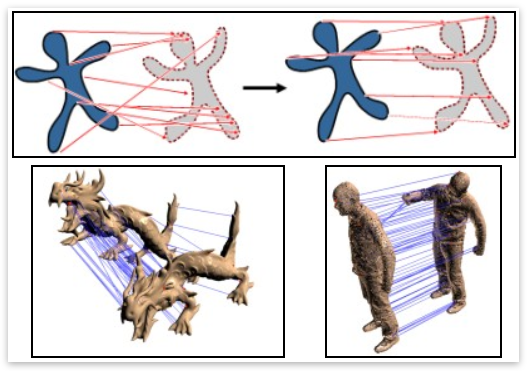
Our goal is to find dense correspondences between deformed shapes. We assume that the deformation the shape has undergone is intrinsically isometric, i.e., does not change geodesic distances within the deformed surface. However, we have to address the problem of topological noise (partial data, acquisition holes, apparant connections if for example the hand of a person gets to close to the body). We are looking at algorithms that can perform global isometric shape matching witout prior initialization and under topological noise. The key observation is that isometries between 2-manifolds have only very few degrees of freedom so that correspondences can be extrapolated from a small set of parameters that are easy to guess, even under noisy and partial data.
Key Publications
- A. Tevs, A. Berner, M. Wand, I. Ihrke, H.-P. Seidel: Intrinsic Shape Matching by Planned Landmark Sampling. In: Computer Graphics Forum (Proc. Eurographics), 2011.
project page (link), paper (20MB) - A. Tevs, M. Bokeloh, M.Wand, A. Schilling, H.-P. Seidel: Isometric Registration of Ambiguous and Partial Data. In: Proc. IEEE Conference on Computer Vision and Pattern Recognition (CVPR '09), 2009.
paper (2 MB), video (mp4, 30MB) - A. Brunton, M. Wand, Stefanie Wuhrer, Hans-Peter Seidel, Tino Weinkauf: A Low-Dimensional Representation for Robust Partial Isometric Correspondences Computation. In: Graphical Models, 2013.
arxiv preprent (earlier version) full paper (pubisher site)
Animation Reconstruction
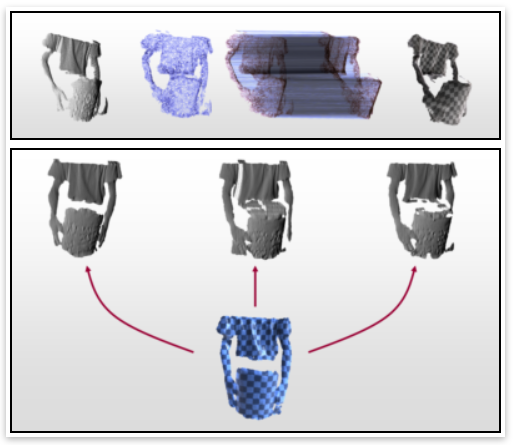
We consider sequences of point clouds that shows a deformable shape in motion, as obtained from real-time 3D scanners. This means we have typically acquisition holes so that the shape is only shown partially in each frame. In addition, no correspondence information is given by the data. Our goal is to reconstruct shape and motion simultaneously, including dense correspondences over time and completed geometry in every frame that matches the data and behaves plausibly in unobserved areas. We refer to this problem setting as animation reconstruction.
Key Publications
- A. Tevs, A. Berner, M. Wand, I. Ihrke, M. Bokeloh, J. Kerber, H.-P. Seidel: "Animation Cartography - Intrinsic Reconstruction of Shape and Motion", In: ACM Transactions on Graphics, 2012.
project page (link), paper (10MB), video (mp4, 290MB) - M. Wand, B. Adams, M. Ovsjanikov, A. Berner, M. Bokeloh, P. Jenke, L. Guibas, H.-P. Seidel, A. Schilling: Efficient Reconstruction of Non-rigid Shape and Motion from Real-Time 3D Scanner Data. In: ACM Transactions on Graphics 28(2), April 2009.
paper (8 MB), video: avi/xvid (56MB), quicktime (66MB). - B. Adams, M. Ovsjanikov, M. Wand, H.-P. Seidel, L. J. Guibas: Meshless Modeling of Deformable Shapes and their Motion. In: ACM SIGGRAPH/Eurographics Symposium on Computer Animation, 2008.
paper (4 MB), video (Youtube) - M. Wand, P. Jenke, Q. Huang, M. Bokeloh, L. Guibas, and A. Schilling: Reconstruction of Deforming Geometry from Time-Varying Point Clouds.
In: Proc. 5th Eurographics Symposium
on Geometry Processing, Barcelona,
Spain, pp. 49-58, 2007.
paper (0.6 MB), video (DivX, 36 MB)
OLDER PROJECTS
Algorithms and Data Structures for Large Scene Editing
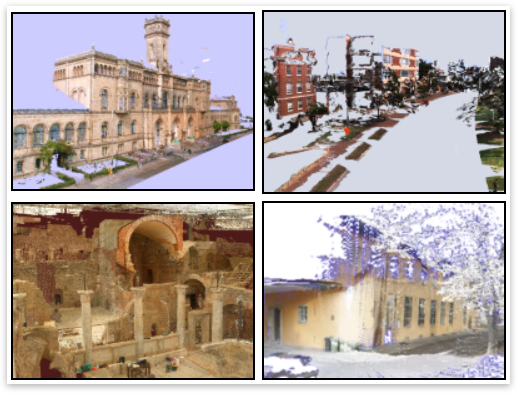
We consider the problem of handling large amounts of geometric data. We have developed a new data structure that allows for real-time editing and visualization of large out-of-core 3D data sets, with size limited only by available hard disc space. We have also developed an open and modular system architecture that uses this data structure as an abstract geometric data base to implement a real-time large scene editor application, supporting interactive local editing, various streaming geometry processing algorithms, and large animation sequences.
Key Publications
- M. Wand, A. Berner, M. Bokeloh, A. Fleck, M.
Hoffmann, P. Jenke, B. Maier, D. Staneker,
A.Schilling:Interactive Editing of Large Point Clouds. In: Proc. Symposium on Point-Based
Graphics (PBG 07), 2007.
paper (3.9 MB), video (DivX, 46 MB) - M. Wand, A. Berner, M. Bokeloh, P. Jenke, A. Fleck, M.
Hoffmann, B. Maier, D. Staneker,
A.Schilling, H.-P. Seidel: Processing and Interactive Editing of Huge Point Clouds from 3D Scanners. In: Computer and Graphics, 2008. - Software: The XGRT system - this is a complete point cloud processing software framework with graphics user interface that can handle very large data sets interactively.
Project page and download (binary &
source code, GPL)
3D Reconstruction

In this project, we have investigated statistical shape spaces as a tool for surface reconstruction. We infer the most likely original shape given a noisy measurement (in the sense of maximizing the posterior propability density for a given statistic measurement model and user defined shape priors).
Key Publications
- P. Jenke., M. Wand, M. Bokeloh, A. Schilling, W. Strasser: Bayesian Point Cloud Reconstruction. In: Computer Graphics forum 25(3), 379-388 (Proc. Eurographics 2006), 2006.
paper (3.5 MB) - Q.-X. Huang, B. Adams, M. Wand: Bayesian Surface Reconstruction via Iterative Scan Alignment to an Optimized Prototype. In: Proc. 5th Eurographics
Symposium on Geometry Processing, Barcelona, Spain, 2007.
paper (21 MB)
Stochastic Synthesis of Complex 3D Models
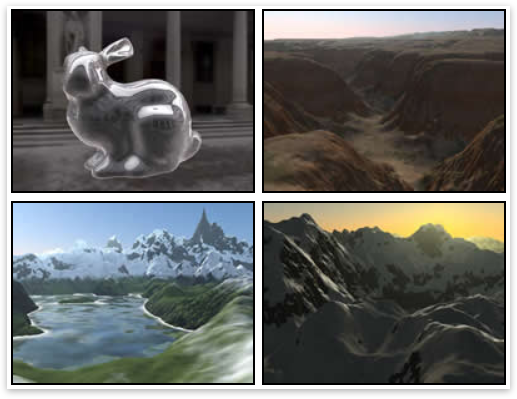
Here we consider forward-modeling: We use a generative stochastical model to create objects procedurally. We develop a new hierarchical, bounded support subdivision, multi-channel geometry synthesis technique that is able to create complex, non-stationary fractal objects in an intuitive way. By specifying some simple multi-variate subdivision rules, models ranging from smooth patches to complex landscape models can be created. Due to a GPU implementation, the technique works in real-time, allowing to zoom into objects with virtually infinite detail.
Key Publication
